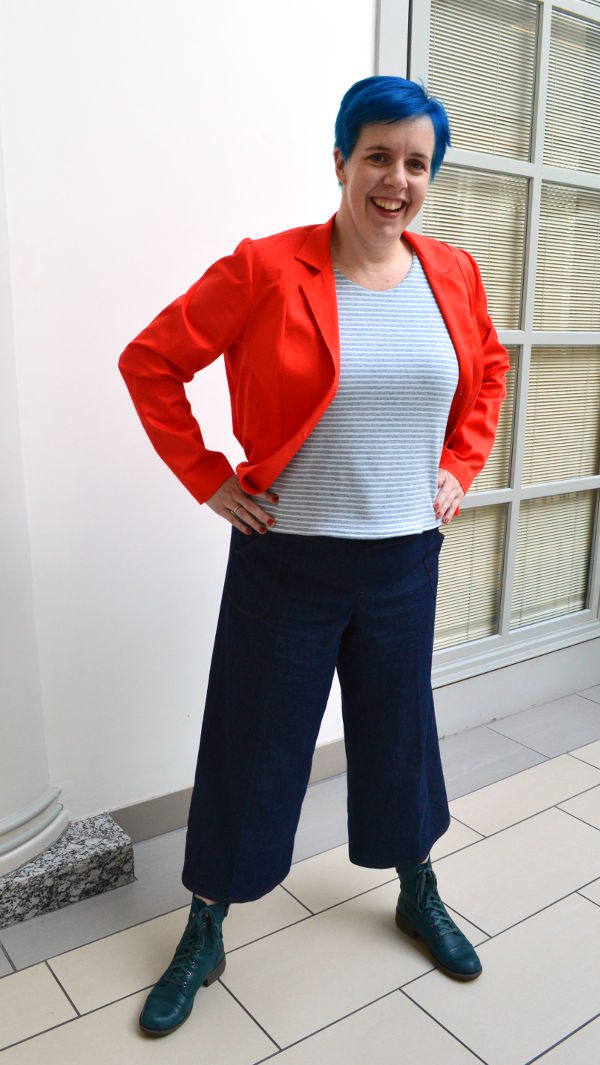Over the last few years, I’ve been getting more interested in going beyond just sewing construction and learning about design principles. This relates to designing individual garments and thinking about a collection of garments, like a capsule wardrobe. It started with the Me-Made wardrobe in orange and blue that I made in 2016. That whole experience really sparked something!
Every now and then I entertain notions of developing more skills in fashion design so I can put my sewing skills to use in a more creative context. The idea of sewing for other people and responding to “client” interests promptly vetoes out those notions. But the idea of developing a cohesive and intentional design concept for the clothing I make for my wardrobe is pretty appealing. This conflicts with the idea of having freedom to make whatever I want, whenever I want, based on the flights of fancy or whatever squirrel-like “pretty” I pick up from the fabric store. I can’t always sew with long-term goals in mind… sometimes I have to just sew to capture the whim of a moment!
That said, for the last two years I’ve been thinking about my wardrobe in terms of colour stories, not just in terms of buying fabric/making things but also in what garments I pick up when I’m shopping retail.
My sketching/drawing skills are pretty rudimentary, and I find that most often I am inspired by what fabric I come across. I’d like to level up my ability to use inspiration to put together a design concept and carry it across multiple garments, hopefully from the design sketch through patternmaking to construction.
I’ve been watching Suzy Furrer’s classes on Bluprint (and have been feverishly capturing the content for when Bluprint shuts down) and I can’t see any reason why I should go on using commercial patterns. For the amount of time I normally invest into adapting commercial patterns for my body size/shape, I could start from a well-fitting sloper and just make my own patterns. With these classes under my belt (it will take a while for me to watch all of them of course… there’s at least 30 hours of material there), I should be able to produce a pattern and then make any garment my heart desires!!
Here are some design exercises that Suzy presents in her class on Drafting Tops. I’m going to work through them because, as emphasized below, I want to figure out who I am as a designer!
Shapes (Black & White)
Goal: Identify shapes you are attracted to.
• Find 10 to 12 images in black and white that speak to you. Black-and-white images allow you to see shape without being distracted by color.
• Place the images as a collage or one or two images to a page. Use only 10 to 12 images — no more! This will help you learn to edit.
• Use images found in nature, architecture, typography, markets, travel, sculpture, art, furniture, car design, anything at all, as long as the images do
not show fashion. No clothed people! You do not want to be influenced by other fashion design at this point. You want to figure out who YOU are as a designer.
• As you select images and discover the shapes you’re attracted to — shapes with a lot of volume or movement, hard edges, soft edges, organic shapes
— you may start seeing a mood come through.
Color
Goal: Find a color story.
• Find 10 to 12 images in and of color that speak to you. As with the Shapes exercise, limit yourself to 10 to 12.
• Collect the images on one page or side-by-side pages so you can see a color story emerge.
• These images can be things that speak to you or images you select for the color alone. Try not to think too much; just include what brings out an
emotion in you. A mood will start to come through with the colors you choose.
• You can find images found in nature, architecture, typography, markets, travel, sculpture, art, furniture, car design — anything at all as long it the images do not show fashion. No clothed people! You still do not want to be influenced by other fashion design. Again, we are trying to figure out who YOU are as a designer.
Texture
Goal: Identify your texture preferences.
• Find examples of texture.
• Limit yourself to filling a full page in your sketchbook. As long as the page is full it does not matter how many examples you include.
• Texture can be fabric such as faux fur, napped fabrics, fabric flowers, beading, sequins, jewels, leather, suede, pleating or other types of fabric
manipulation, zippers, buttons, or trims. You can also use pictures such as the textures found in nature — perhaps later you will find a way to recreate those natural textures in fabric.
Mood Board
Goal: Develop a design theme
• Fill a page in your sketchbook with design inspiration.
• With this exercise, start including images of fashion and people.
• You can also include postcards, quotes, photographs, findings such as jewels, small toys, buttons and trims and objects found in nature.
• Your board can be very organized or controlled chaos — approach it anyway you like. The only requirement is that it fits on one page or two side-by-side pages. You want to be able to look at it as a whole and figure out a theme for your collection.
• The theme might come from one object on your mood board or from the vibe the entire mood board is giving off.

